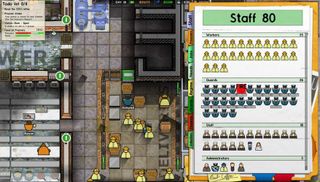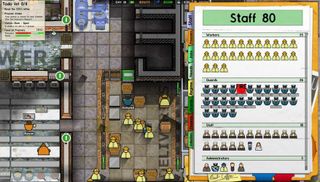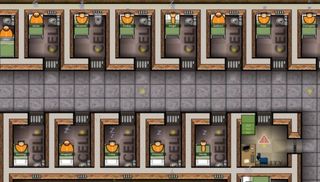Prison Architect: how Introversion avoided jail by embracing their hardest project yet

The Great Escape reference is significant. Prison Architect isn't aiming to simulate a real-world prison, but the idea of prisons as they exist in the public consciousness. That means it's not really set in America, despite the iconic orange jumpsuits, and it means that tunnelling is a problem, when real prisons have steel re-inforced walls that make tunnelling impossible.
“As soon as we say 'the game is set in America' or 'this prison is in Scandinavia' or 'this is a British prison', we just create all these false connections of what it should be like that we're not really interested in creating,” says Chris.
This doesn't necessarily mean cutting features entirely, but it does mean making sure those features are applicable across cultures, like the game's treatment of gangs. “Our gangs are like street-punk gangs. The American systems have got vast organisations. The Aryan Brotherhood was such a big gang at one point that they managed to arrange to have a whole bunch of other Aryan Brotherhood senior members transferred to the same jail temporarily, and they had seniorlevel board meetings. I don't think this exists in British jails.
“If you go to South American jails, they're completely different again - they're heavily into drug cartels, very violent and often have huge areas of the jail that are no-go areas for the guards and staff and are self-policed. They're almost like a rough neighbourhood, but the guards would never dare go in because it's just too dangerous.” Setting it in a nowhereland allows Chris and the team to dig their own tunnel around some of the setting's politically dangerous terrain. “In the very first trailer we ever did, we only had one prisoner sprite, and he was white. Somebody posted a comment saying, 'I see there are no black prisoners and no black guards. No surprise that a bunch of white guys from Britain would be utterly racist in their presentation of prisons.'” Avoiding geographical ties - and even a specific time period - makes it easier to be ambiguous about these other issues.
The solution was to make skin colour random for the entire population, but it wasn't an easy decision. “We obviously had a discussion of, 'are we going to model the percentages of each racial group that'll be in the jail, because that would be realistic?' No, I don't think so. Even though it is based on reality, it's still potentially racist to do that. And for what? You've gained no gameplay mechanic for doing that.”

Even by sidestepping contentious issues like race, and darker material like prison rape, Prison Architect has to walk a fine line in how it balances its simulation. Not everyone's idea of prison is the same, and there's a difference between the statistical realities of incarceration, and the role plays in people's ideology. As an example: there are a lot of studies which detail how best to reform prisoners, but not everyone agrees that prisoners should be reformed.
Speaking to Chris, it's clear that he's read a lot of those studies, and a lot about prisons around the world and throughout history. It's also clear that he has his own worldview, even as he fights to make sure the game allows multiple playstyles.
The biggest gaming news, reviews and hardware deals
Keep up to date with the most important stories and the best deals, as picked by the PC Gamer team.
“We have this sort of long-standing aim to make it possible to have a right-wing prison,” says Chris. “Not because we're right-wing. Our game is ridiculously left-wing at the moment, because at the moment the way to win is to satisfy your prisoners' needs, which is a profoundly leftie view on how prisons should operate.
“So you should be able to run a prison whereby the punishments for anything can be turned up to 11 and be ridiculously over-the-top, so even complaining gets you an hour in solitary. Then, once you've had your hour in solitary, you should be suppressed for a whole day. You're under the power of the prison, and you don't have the will to fight back for at least a day or so, and the more extensive your punishment regime, the more that will happen.”
Prison Architect isn't set anywhere specific, but there should also be room within the simulation to create real styles of prison. “You'll be able to build American-style supermax prisons. American supermax prisons are basically like your worst nightmare, whereby you spend about twenty-three hours in your cell every day and you get about an hour of exercise and zero human contact. Just basically hellish, horrible places, and we should be able to make prisons like that in Prison Architect as a valid strategy.”

The way to do that is through a planned Civilization-style scoring system. When each of your prisons comes to an end you'll be presented with a set of stats about how well you did: simple numbers like how many prisoners you held, but ultimately also how strongly you punished your prisoners, how well you protected society by stopping them from escaping, and how well you reformed them by discouraging them from re-offending upon release.
Things will work a little differently in the game's campaign, where the simulation at its core remains the same, but the story aims to explore more specific political issues.
Chris doesn't want to spoil the story, but he does offer up one example. “We have a chapter where a politician decides that he would like to run an experiment. He says to you that you should try and create a full reform prison where budget is no object. Assuming money was no factor, how much could you actually do with a reform prison? How well you do at that level has repercussions in the story.
“That's where we're going to try and deal with the really hairy issues head on. And then when people come to play the sandbox, we're hoping that we will have seeded their mind a little bit with some of the moral issues behind each of the decisions they might make. We'll let the player build an execution chamber in the sandbox, and I've no doubt that people are going to build vast execution prisons, but I don't really have a problem with that.”
The harder part of balancing the game is making sure that no single strategy overpowers everything else: both because of the ideological message that would send, and because that min-maxing playstyle can discourage players from being creative with their designs.
Most Popular


